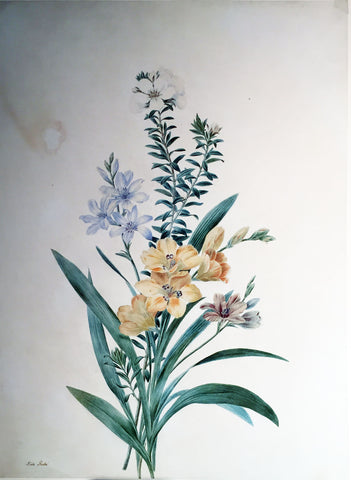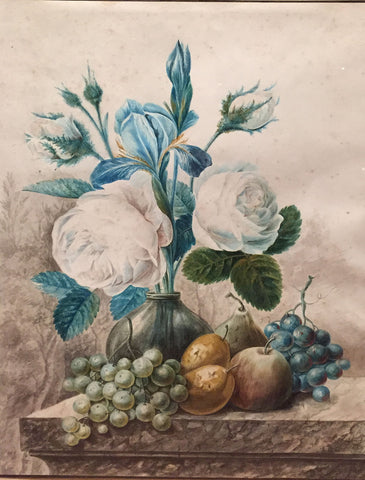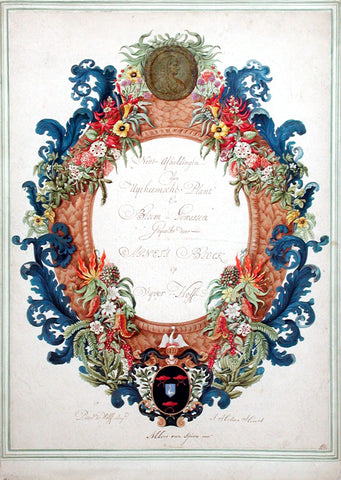
Joseph Melling (French, 1724-1796), Cactus grandiflorus (Selenicereus grandiflorus)
Joseph Melling (French, 1724-1796)
Cactus grandiflorus (Selenicereus grandiflorus)
Black chalk, watercolor, bodycolor, heightened with touches of gold,
black ink framing lines on paper
Signed and inscribed ‘Peint par Joseph Melling. Maitres de Desein des Ecolle[s] Normale[s]’ (the ‘s’ added in another ink) and further inscribed ‘Cactus grandiflorus. Lin: Sÿst: nat: ed:n XIII. vind: pag: 338. ii. Sp: pl: 668. Florigem Sistem 32 ZH[?] Unitn[?] 630. Grossblümige Sackel Sistel. Volk: Hesp: I. pag: 133. t: 134. Floruit in horto AugaeArchiducis Mariae Annae Clagenfurte Mense Junio 1784’
[Bloomed in the garden of Archduchess Maria Anna at Klagenfurt in June 1784]
Paper size: 20½ x 14 in.
First described by Linnaeus in his Species plantarum (1753) as Cactus grandiflorus, this variety is now known as Selenicereus grandiflorus is commonly called the queen of the night or night-blooming cereus. It is a cactus species originating from the Antilles, Mexico and Central America.
The inscription at the foot of the drawing provides references to the cactus in the botanical literature of the time, including Linnaeus’s System naturae, 13th ed. (1780) and to Johann Christoph Volkamer’s Nürnbergische Hesperides, Oder Gründliche Beschreibung Der Edlen Citronat-Citronen-und Pomerantzen-Früchte (1708). Below the scientific details, Melling references the garden at Klagenfurt owned by Archduchess Maria Anna of Austria (1738-1789), daughter of Queen Maria Theresa and Emperor Francis I and sister of Queen Marie-Antoinette. An intelligent and enquiring woman, she was made an abbess first of a convent in Prague and then of one in Klagenfurt, where she was at the center of an intellectual circle which devoted itself to the study of sciences such as botany, numismatics and mineralogy.
Archduchess Maria Anna (known as Marianna) was the second but eldest surviving daughter of Maria Theresa, Queen of Hungary and Bohemia, and Francis I, Holy Roman Emperor, she was heiress presumptive of the hereditary lands of the Austrian Habsburgs between 1740 and 1741, until her younger brother Joseph (later to be the Holy Roman Emperor Joseph II) was born.
Maria Anna had a close relationship with her father, and reportedly became Francis I’s favorite child. She shared his interest in science and conducted experiments in chemistry and physics. The death of Emperor Francis I on 18 August 1765 was a devastating blow for Maria Anna. In 1766 Maria Anna was made Abbess of the Imperial and Royal Convent for Noble Ladies (Frauenstift) in Prague with the promise of 80,000 florins per year. Despite the opposition of her mother, she decided to give up the Prague position and became an abbess in Klagenfurt with a smaller provision. A palace for her was completed in 1771.
Despite her talents and intelligence, Maria Anna was disliked by high society because her scientific interests were considered unsuitable for her gender, but she was appreciated by the scientific and art world. She was an important patron of the arts and was made a member of both the Vienna Academy of Art and the Florence Academy of Art, as well as gaining the respect of the scientific community for her patronage of research and scholarly pursuits. Her friends were nuns, artists, scientists, and nobles, some of them belonged to the Freemasons. In 1783, the Klagenfurt Masonic Lodge was founded with a dedication “to charitable Marianna” (Zur wohltätigen Marianna.) Maria Anna devoted herself in Klagenfurt to her scientific interests notably her fine garden both of which would have put her in contact with artist Joseph Melling who founded Academie de déssin d’après nature.
The inscription at the foot of the drawing provides references to the cactus in the botanical literature of the time, including Linnaeus’s System naturae, 13th ed. (1780) and to Johann Christoph Volkamer’s Nürnbergische Hesperides, Oder Gründliche Beschreibung Der Edlen Citronat-Citronen-und Pomerantzen-Früchte (1708). Below the scientific details, Melling references the garden at Klagenfurt owned by Archduchess Maria Anna of Austria (1738-1789), daughter of Queen Maria Theresa and Emperor Francis I and sister of Queen Marie-Antoinette. An intelligent and enquiring woman, she was made an abbess first of a convent in Prague and then of one in Klagenfurt, where she was at the center of an intellectual circle which devoted itself to the study of sciences such as botany, numismatics and mineralogy.
Archduchess Maria Anna (known as Marianna) was the second but eldest surviving daughter of Maria Theresa, Queen of Hungary and Bohemia, and Francis I, Holy Roman Emperor, she was heiress presumptive of the hereditary lands of the Austrian Habsburgs between 1740 and 1741, until her younger brother Joseph (later to be the Holy Roman Emperor Joseph II) was born.
Maria Anna had a close relationship with her father, and reportedly became Francis I’s favorite child. She shared his interest in science and conducted experiments in chemistry and physics. The death of Emperor Francis I on 18 August 1765 was a devastating blow for Maria Anna. In 1766 Maria Anna was made Abbess of the Imperial and Royal Convent for Noble Ladies (Frauenstift) in Prague with the promise of 80,000 florins per year. Despite the opposition of her mother, she decided to give up the Prague position and became an abbess in Klagenfurt with a smaller provision. A palace for her was completed in 1771.
Despite her talents and intelligence, Maria Anna was disliked by high society because her scientific interests were considered unsuitable for her gender, but she was appreciated by the scientific and art world. She was an important patron of the arts and was made a member of both the Vienna Academy of Art and the Florence Academy of Art, as well as gaining the respect of the scientific community for her patronage of research and scholarly pursuits. Her friends were nuns, artists, scientists, and nobles, some of them belonged to the Freemasons. In 1783, the Klagenfurt Masonic Lodge was founded with a dedication “to charitable Marianna” (Zur wohltätigen Marianna.) Maria Anna devoted herself in Klagenfurt to her scientific interests notably her fine garden both of which would have put her in contact with artist Joseph Melling who founded Academie de déssin d’après nature.
JOSEF MELLING (FRENCH, 1724-1796)
Joseph Melling came from a long-established line of painters, etchers, architects, and woodcarvers. His father came to Saint-Avold to participate in the rebuilding of a monastery and its church. He attended the Lateinschule in Saarlouis and went to Paris to complete an apprenticeship in carpentry. After that, he studied with Carle van Loo and François Boucher. In 1750, he was awarded the Prix de Rome in painting for his version of Laban giving his daughter to Jacob. It is not clear if he went to Rome, but it is probable that he did some church painting with his uncle Valentin Metzinger in Laibach.
In 1758, he joined his brother, the sculptor Christoph Melling (1716-1778), as a court painter for the Margraviate of Baden Karlsruhe. He also served as an advisor to Countess Karoline Luise, helping her to acquire an art collection that later became the basis of the Staatliche Kunsthalle Karlsruhe. He also operated a drawing school in what was once the palace’s menagerie.
In 1774, for financial reasons, he left Karlsruhe for Strasbourg, where he founded an art school; the “Academie de déssin d’après nature.” He retained his contacts with the court, and after the death of Karoline Luise in 1783, he created a catalog and directory of her collection. In 1789, during the French Revolution, his school was superseded by a system of centrally-controlled state schools. Six years later, he was able to open a private school, supported by his son, the painter Joseph Ignaz Melling (1764–1817), who later operated his own art school in Rastatt.
In 1758, he joined his brother, the sculptor Christoph Melling (1716-1778), as a court painter for the Margraviate of Baden Karlsruhe. He also served as an advisor to Countess Karoline Luise, helping her to acquire an art collection that later became the basis of the Staatliche Kunsthalle Karlsruhe. He also operated a drawing school in what was once the palace’s menagerie.
In 1774, for financial reasons, he left Karlsruhe for Strasbourg, where he founded an art school; the “Academie de déssin d’après nature.” He retained his contacts with the court, and after the death of Karoline Luise in 1783, he created a catalog and directory of her collection. In 1789, during the French Revolution, his school was superseded by a system of centrally-controlled state schools. Six years later, he was able to open a private school, supported by his son, the painter Joseph Ignaz Melling (1764–1817), who later operated his own art school in Rastatt.
Please feel free to contact us with questions by phone at 215.735.8811,
or by email at loricohen@aradergalleries.
We Also Recommend





